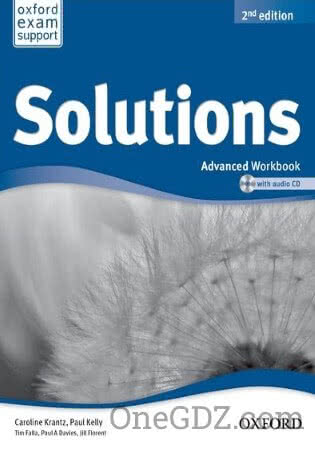
ГДЗ Solutions Advanced Workbook (2nd edition) answer key
Додаток
Get ready for your exam 1 page 19–20
• The Workbook Get ready for your exam lessons can be used as extra classroom lessons, as controlled exam practice or as independent study for homework. All the audio material for the listening tasks is on the Solutions Multi-ROM.
• Reading: Elicit strategies for dealing with the sentence insertion task. Remind the students to identify the topic of each paragraph, and the function of each missing sentence.
• In a weaker class, work on the first gap together, identifying the topic before and after the gap and looking for clues as to what is missing.
• Remind the students to make sure, after they have finished the task, that the remaining sentence does not fit in any of the gaps.
• Use of English: Encourage the students to read the whole text first to grasp the overall meaning. Remind them to focus on grammatical correctness within the whole article.
• Listening: Remind the students that in this type of task the order of the statements fits the order of the information in the recording. Tell them to prepare for the listening by reading the sentences carefully and underlining any key words. Encourage them to eliminate the wrong answers as well as identifying the correct one. Play the recording twice.
• Writing: Read through and discuss the tasks together, then refer students to the Writing Bank for guidance. Students plan an article or review to be written at home or in class.
• Speaking: Elicit strategies for the task from the students. Remind them to talk about each picture, comparing / contrasting them rather than just describing them. If necessary, in a weaker class, brainstorm ideas about both pictures before starting. Students work in pairs to do the task.
• Reading: 1F, 2C, 3 E, 4 A, 5 B, 6 G
• Use of English: 1 c, 2 b, 3 b, 4 b, 5 d, 6 d, 7 d, 8 d, 9 d, 10 c
• Listening: 1 a, 2 b, 3 c, 4 d
Transcript WB 05
About 9,000 years ago, when migrating hunter-gatherer societies turned to the settled life of farming, they began to develop ways to record the number of animals they owned, or the amount of crops, and to keep a calendar for proper crop planting. The first attempts at writing it all down were ‘clay counting tokens’, which were found in the region which is now modern Turkey and Syria. These tokens were simply lumps of clay shaped like spheres, disks or cones and could either be plain or decorated. Each of them stood for one word. However, carrying them around was bothersome and gradually a transition from three-dimensional tokens to two-dimensional signs began. Around 4000 BC the ancient Sumerian scribes started to imprint shapes into clay tablets to represent the tokens. Now one tablet could contain more than one word. Originally, these pictures simply represented whole concepts such as names and numbers. But with time they were simplified and refined and eventually evolved into signs representing the consonants of the language. The first true alphabet was the Semitic alphabet which appeared around 1700 BC, followed, about 700 years later, by the Phoenician system. At this point the alphabet as we know it today was almost in its final form. The final touch was added by the early Greeks, who introduced vowel symbols to their alphabet. The descendants of this alphabet were Latin and Cyrillic, which were then spread far and wide by their respective users. The fact that Latin was the official alphabet of the Roman Empire, which at one point covered most of Europe, helped to establish this alphabet as the accepted way of writing across the continent. Along with their alphabet the Romans popularised the particular way in which they wrote their letters — the script. The reason behind the shapes of the early Roman script is very simple: the Romans loved writing on their buildings. The technique of engraving letters onto stone requires letters made up mostly of straight lines. This script was the ancestor of the ‘Times New Roman’ font we find on our computer screens today. Another feature familiar to computer users is ‘italics’. Initially, characters written by hand resembled the carved letters, but gradually scholars began to change the form of their writing, slanting letters and connecting them. The credit for inventing Roman script using capitals and small letters goes to Aldus Manutius of Venice, in 1495 AD. The old Roman capitals and Greek letter forms were thus transformed into the twentysix alphabet letters that we know today, with both upper and lower-case letters in common use by the end of the sixteenth century.